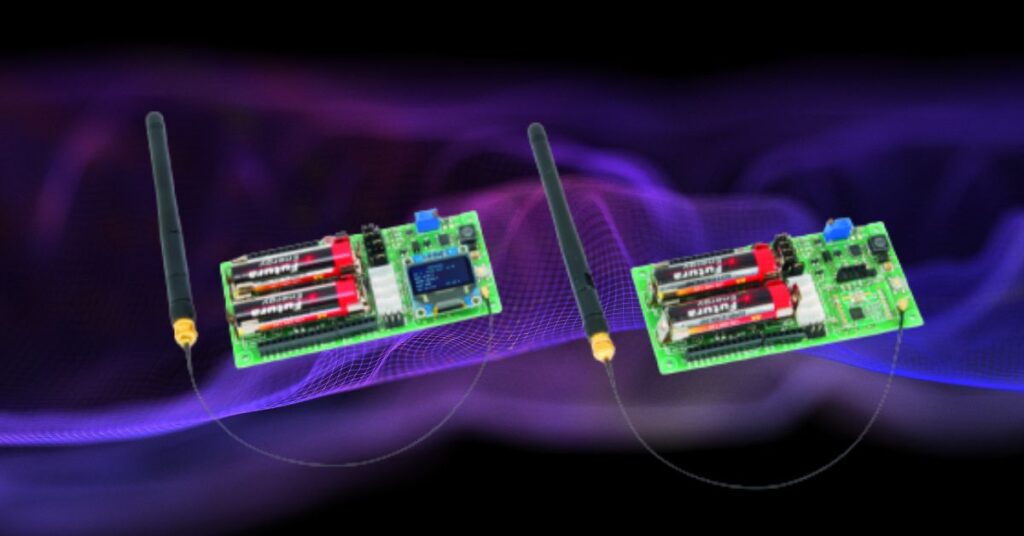Antennino is a tiny, open-source, low-power module that enables radio frequency wireless communication between devices. It was created with simplicity in mind, enabling people to connect devices without the need for large antennae or Wi-Fi routers. It is extensively utilized in embedded systems, smart automation, and Internet of Things (IoT) projects. Antennino is enabling wireless communication for educators, engineers, students, and hobbyists worldwide because of its small size, low cost, and simplicity of integration.
It facilitates the short- to medium-distance transfer of data and signals between sensors, switches, and microcontrollers. This makes it possible to install smart technologies in places where standard wireless infrastructure might not be practical, such as houses, farms, classrooms, and even outdoor grounds. It is even more well-liked by the maker and do-it-yourself groups because of its plug-and-play capabilities and compatibility with open-source hardware platforms.
Who Created Antennino?
Antennino was developed by a group of enthusiastic Italian engineers and tinkerers who valued open-source cooperation. The project began as a means of making antenna design easier for electronics hobbyists who wished to construct wireless devices without having to deal with intricate radio frequency circuits. The group refined the design over time, added modularity, and allowed for global contributions.
The idea behind Antennino is just as distinctive as its technology. The designers aimed to reduce the entrance barrier in radio communication by providing a versatile, reasonably priced system that even novices could use efficiently. In the world of the Internet of Things, it now represents community-driven innovation.
Also Read: Everything You Need to Start a DIYSticker Business from Home with LienePixCut S1
How Does Antennino Work?
Low-power radio signals are sent and received by the antenna. It enables wireless message transmission between microcontrollers such as Arduino, ESP8266, or Raspberry Pi. These signals have the ability to issue alerts, relay sensor data, and control devices.
Frequencies like 433 MHz and 868 MHz, which are common in residential and commercial automation systems, are usually used by the module. After connecting, users only need to write basic code to initiate communications; no extensive understanding of radio frequency is required. One-way and two-way communication are both possible, and a mesh network made up of numerous antenna modules allows for more extensive and reliable data sharing between numerous devices.
Why Is Antennino So Small Yet So Powerful?
The engineering of the antenna is what makes it so brilliant. It’s approximately the size of a coin, but inside it has components tuned for energy efficiency, signal strength, and wide compatibility. It has circuitry to guarantee reliable data transfer, an integrated antenna or antenna connector, and a microcontroller.
Long-range communication in open areas is supported by the antenna despite its small size, and battery-powered devices benefit greatly from its low voltage and current requirements. It does its job without taking up much room or energy, whether it is integrated into a door alarm or a tiny weather sensor.
What Are the Main Uses of Antennino?
Antennino is versatile. It’s used in:
Smart Homes: To control lights, monitor windows and doors, or detect motion.
Agriculture: Farmers use it in soil moisture sensors, weather stations, and automated irrigation systems.
Education: Teachers use it to explain radio communication in classrooms with fun, hands-on experiments.
DIY Projects: Makers build wireless gadgets like remote pet feeders, alarms, or temperature readers.
Industry: Companies integrate it into machines to send real-time data on operations and faults.
Its ease of use and affordability allow users to explore and build without fear of breaking expensive equipment.
How Easy Is It to Use Antennino?
The antenna was designed to be simple. Simply connect the module to your Arduino board, upload a simple sketch (code), and you can begin sending signals almost immediately—even if you’re not familiar with electronics. Neither a complex setup nor an internet connection are required.
To help new users step-by-step, there are a ton of community tutorials, videos, and forums available. For many microcontrollers, it also supports plug-and-play, which eliminates the need for additional drivers or libraries during initial setup. You can wirelessly send and receive messages with just a few lines of code.
What Are the Technical Features of Antennino?
Antennino is built to perform efficiently in small systems. Common technical specs include:
Operating Frequency: 433 MHz or 868 MHz
Communication Range: Up to 300 meters in open air
Voltage: 3.3V to 5V
Current Consumption: Very low, suitable for battery power
Supported Boards: Arduino, ESP8266, ESP32, STM32, and more
Data Rate: 1–20 kbps depending on environment and settings
These specs make it suitable for both indoor and outdoor applications where Wi-Fi might not reach or be practical.
Also Read: Photeeq Lens Flare: Enhancing Photos with Realistic Light Effects
Is Antennino Better Than Traditional Antennas?
Conventional antennas are often made for long-range, high-power communications, such as TV or Wi-Fi signals. They can be costly, large, and challenging to mount. By providing a compact, integrated solution designed for small electronics, Antennino revolutionizes the market.
Large antennas won’t be replaced by it in telecom applications, but it works far better in do-it-yourself or low-power systems where cost, energy, and space are important considerations. Additionally, it is made to function for short-range communication right out of the box, so you don’t have to bother about tuning or directional positioning.
Can Antennino Be Customized?
Indeed! The adaptability of Antennino is one of its best qualities. You can add encryption, configure sleep modes, or change the signal intensity to customize the firmware to your exact specifications. If you wish to increase the antenna range or add sensors, you can also make hardware changes.
All design data, schematics, and firmware are freely accessible online because to its open-source nature. Because of this, it is perfect for researchers, students, and startups who want to customize it for special uses.
Where Is Antennino Being Used Today?
There are hundreds of real-world applications for antennas worldwide. Farmers in Italy have used it to keep an eye on temperature and humidity in their grapes. Students use it to construct weather stations in schools all around Europe. Startups in Asia are using it in outdoor trackers, gas leak detectors, and smart door sensors.
Its use is still expanding, particularly in poor nations where affordable technology is essential for intelligent agricultural, water, and energy solutions.
How Does Antennino Perform in the Real World?
When utilized within its intended parameters, users constantly report that Antennino operates dependably. It performs exceptionally well in situations where Wi-Fi and Bluetooth can falter, particularly for straightforward, recurring tasks like remotely turning on or off devices or checking sensor results.
Although range and interference can affect performance, most users experience consistent, long-term performance using simple setup techniques including avoiding congested frequencies and positioning modules at a height.
What Are the Limitations of Antennino?
Despite its impressiveness, Antennino has drawbacks. For high-bandwidth operations like streaming audio or video, it is not designed. Barriers like metal surfaces or concrete walls might interfere with communication. In urban settings, range may decrease.
Furthermore, it cannot function independently like a Wi-Fi gadget because it needs a microcontroller to function. Despite its efficiency, battery life is still influenced by the power source’s size and transmission frequency.
How Can You Get Started With Antennino?
Ordering an Arduino Nano or other comparable development board and an antenna module should be your first step. To program it, use a USB-to-serial adaptor. Upload sample code from internet tutorials or documentation after wiring the components.
Simple projects include soil moisture monitors, door open warnings, and wireless temperature sensors. You can then go to mobile communication devices, remote control systems, and multi-node mesh networks.
Is There a Community Supporting Antennino?
Indeed! The Antennino user base consists of educators, engineers, students, and enthusiasts. There are a ton of sample projects, troubleshooting advice, and improvement ideas on forums like GitHub, Reddit, and electronics communities.
Additionally, an expanding collection of code snippets, diagrams, and shared project logs makes it simpler for novice users to get started and for more experienced users to work together or come up with new ideas.
What’s Next for Antennino?
In addition to supporting protocols like LoRaWAN, developers are working on integrating Antennino into bigger mesh networks. It is anticipated that future iterations will be much more compact and intelligent, featuring integrated sensors, enhanced encryption, and wider frequency compatibility.
Antennino is becoming more and more popular in wearable technology, public safety systems, and environmental conservation. It will keep changing as more people join the movement because of its open-source model.
Conclusion
Antenna is a trend toward better, easier, and more accessible wireless communication, not just another module. It removes obstacles for anyone wishing to create linked devices with its small size, open-source methodology, and user-friendliness. Antennino is your entryway to the wireless world, regardless of your level of interest in technology or your position as an industry innovator. In homes, companies, classrooms, and gardens alike, it fosters innovation and provides real-time solutions to pressing issues.
FAQs
What devices can I use Antennino with?
It works well with Arduino, ESP8266, ESP32, STM32, and similar microcontrollers.
Does Antennino require coding knowledge?
Basic coding is needed, but many easy tutorials are available for beginners.
How far can Antennino send signals?
In open areas, up to 300 meters. Indoors, the range depends on walls and interference.
Is Antennino safe for school use?
Yes, it’s low-powered and widely used in STEM education projects.
Can I customize its firmware or hardware?
Absolutely. Everything is open-source and modifiable to suit specific needs.

